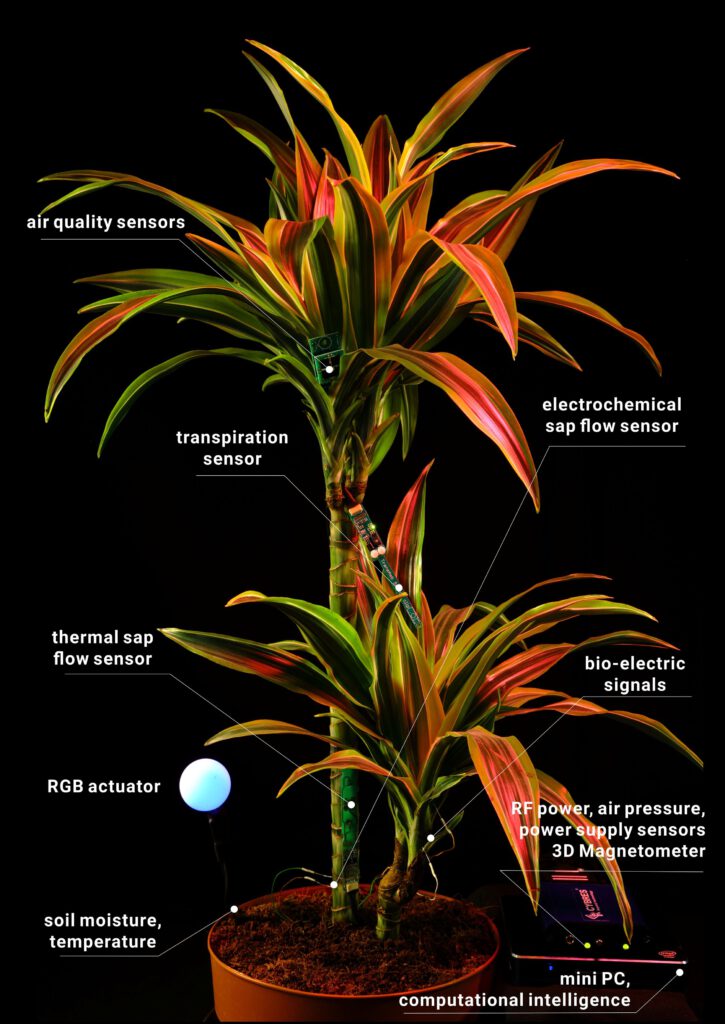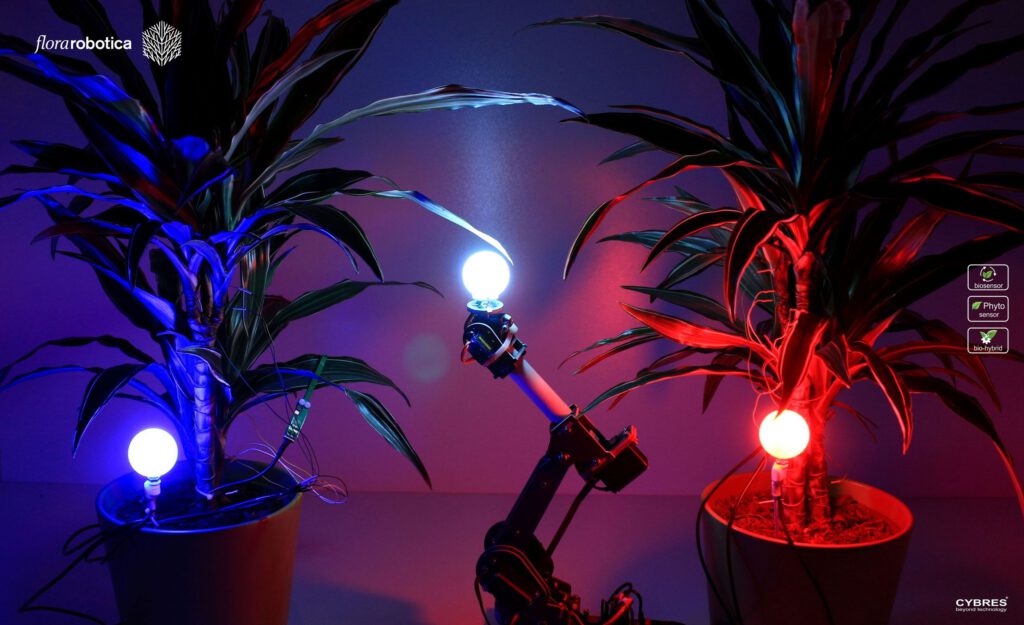Phytosensor- und Phytoaktorsystem

The phytosensor measures physiological and electrophysiological parameters of plants (productive and domestic plants, herbs, shrubs, trees). In addition to phytosensing, the device can perform phytoactuation, i.e. control light, irrigation or fertilization. The combination of phytosensing and phytoactuation allows not only to monitor the physiological state of plants in real time, but also to enable biological organisms to control environmental parameters, optimize growth conditions or cope with stress factors. Phytoactuation based on biofeedback is the next step in the development of hydroponics, vertical farming and controlled environment agriculture.
Das System misst (abhängig von den Elektroden):
- Biopotenziale, 2 Kanäle
- Gewebeimpedanz (Blatt- und Stängelflüssigkeitsgehalt), 2 Kanäle
- Elektrochemische Impedanzspektroskopie (Ionenanalyse von Geweben)
- Blatttranspiration, Blatttemperatur, Einzelkanal
- Saftstrom, elektrochemischer und Wärme-Impuls/Gleichgewicht (optional)
- Bodenfeuchtigkeit und Temperatur (optional)
- Umweltparameter: 3D-Beschleunigungsmesser/Magnetometer, EM-Leistungsmesser, Lufttemperatur und -feuchtigkeit, Druck, Licht (auf externer Sensorplatte)
- Unterstützte externe Sensoren: CO2, O2, ionenselektive Elektroden, beliebige Sensoren mit analoger oder I2C-Schnittstelle
- Impedanzmessungen können eine Mikrostromstimulation durchführen (2 Kanäle)
- Regressions-/Spektral-/Korrelations-/Statistikanalysen in Echtzeit sind für alle Messungen verfügbar.
Steuerung externer Geräte (mit Energiemanagementsystem):
- 6 Halbleiterrelais/ elektromechanische Relais, Hochleistungs-MOSFETs
- 220V/110V-Ansteuerung für Licht (Vollspektren, Fernrot, UV)
- 12V/24V für die Bewässerung (Pumpen oder Solenoide)
- Wasser-/Luftaufbereitung, z. B. pH-Kontrolle, Zugabe von Düngemitteln, Ozonierung/AOP (fortgeschrittener Oxidationsprozess), Belüftung/OMB (O2-Mikrobläschen), magnetische Behandlung
Anwendungen
- professional plant cultivation
- vertikale/indoor Farmen, Landwirtschaft mit kontrollierter Umgebung
- Biofeedback-basiertes Wachstum
- Bio- und Phyto-Sensorik-Systeme
- Pflanzenliebhaber, Unterhaltungs-/Kunstsysteme mit Pflanzen
Zusätzliche Komponenten
- mini-PC (Win 10 Pro, J4125, 8G 128G, HDMI 4K, BT4.2, 2.4G/5.8G Wi-Fi, USB3.0)
- power management module (220V/110V, 12/24V outputs)
- Verfügbare Elektroden: 1) Elektrophysiologie - Biopotentielle 2x, Gewebeimpedanz 2x; 2) alle Sensoren (Bodensensoren optional)
Handbücher, Anwendungshinweise, Veröffentlichungen
- CYBRES Measurement Unit MU3: SHORT MANUAL (English, German, French, Ukrainian, Arabic, Chinese)
- CYBRES EIS for electrochemical and electrophysiological analysis of fluids and organic tissues: EXTENDED USER MANUAL
- Application Note 28. Using phytosensor in precision agriculture, vertical farms, hydroponics and agricultural AI applications
- H. Hamann et al, “Flora robotica – Mixed Societies of Symbiotic Robot-Plant Bio-Hybrids”, IEEE Symposium on Artificial Life (IEEE ALIFE’15), 2015
- Device for measuring the plant electrophysiology, IJUS, Issue 12-13(4), p.138, 2016
- H. Hamann et al, “Flora robotica–An Architectural System Combining Living Natural Plants and Distributed Robots”, arXiv:1709.04291, 2017
- M. Wahby et al, “Autonomously Shaping Natural Climbing Plants: A Bio-hybrid Approach” Royal Society Open Science, 2018
- H. Hamann et al, WatchPlant : Networked Bio-hybrid Systems for Pollution Monitoring of Urban Areas, ALIFE 2021, MIT Press, pp. 118-126, 2021 doi: 10.1162/isal_a_00377
- L. García-Carmona et al, .“Biohybrid systems for environmental intelligence on living plants”, 2021. GoodIT ’21, p. 210–215, 2021, doi: 10.1145/3462203.3475885
- S.Kernbach, Device for measuring the plant physiology and electrophysiology, arXiv:2206.10459v1, 2022
- E.Buss, et al, Stimulus classification with electrical potential and impedance of living plants, Bioinspir. Biomim. 18 025003, 2023, DOI 10.1088/1748-3190/acbad2
- S.Kernbach, Biofeedback-Based Closed-Loop Phytoactuation in Vertical Farming and Controlled-Environment Agriculture. Biomimetics 2024, 9, 640, doi: 10.3390/biomimetics9100640
Video

